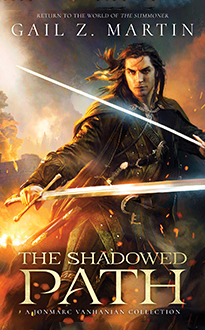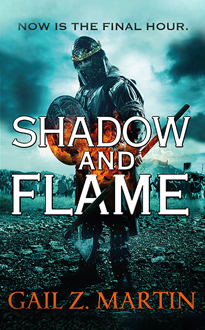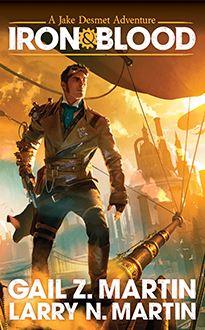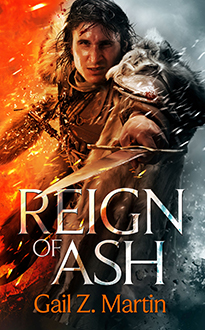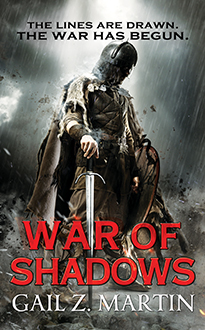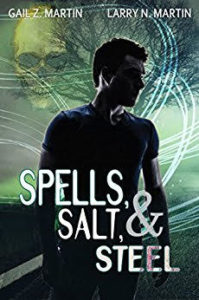by Donald J. Bingle
Many years ago, an amateur graphologist told a business colleague that I was, based on my signature, a serial killer. When she assured the gentleman that she knew the signer of the document and that I was not, in fact, a serial killer, he responded “He may not have killed yet, but I assure you he will.”
All that occurred before I had done much writing, but I’ve done plenty since and I have, in fact, killed many, many since that time … all of them fictional characters. Look, I used to play a lot of tabletop roleplaying games; I used to write and run such games. I know all about killing characters and having characters killed. Having played more than six hundred different RPG characters in my classic tournament roleplaying career (I was the world’s top-ranked RPGA classic player for about fifteen years), having adjudicated failed resurrection rolls, looted the bodies of fallen comrades, and declared to the GM that my player-character was jumping into the maw of a fire-breathing dragon to save the party, I understand that killing off a beloved character, even one made of nothing but toner, paper, and imagination, can be wrenching both for the creator and the spectators/readers, but sometimes it must be done.
What are valid reasons for killing characters (in gaming or fiction)? Here’s a few:
- To heighten tension. Much of fiction is about creating compelling, relatable characters and then creating increasingly difficult and dangerous situations for them to attempt to overcome. If the characters are too powerful or the dangers too small, not only is there not much tension or suspense, but there is nothing to spark the character growth that is important to the protagonist’s character arc. Sure, we all watch and read plenty of things where we know that good will ultimately triumph, but the creator has to somehow make that risk real. One way he or she does that is by killing characters. Sometimes these are secondary characters, comic side-kicks, love interests, or nearby innocents, but nothing ratchets up the feeling of risk like death. Sometime, when you really want to keep your readers/viewers reeling and off-base, you kill off a major character. Sure, in fantasy (and soap operas), they might come back, but you never know. When anyone can die at any moment, you’ve got some built-in suspense.
- To stay true to the character. Sometimes anything but heroic sacrifice feels like a cheat, a betrayal of the morals and values of the character in question. If you’ve purposefully created (or somehow boxed yourself into) such a situation, the only way to resolve it that will ring true is to let the sacrifice be made.
- To increase the pain being inflicted on one or more other characters. Remember when I was talking about increasing the difficulty and danger for the protagonist? Well, death of someone close or innocent or both can create a lot of difficulty and pain. You can then use such pain to fuel the change in that surviving character’s/protagonist’s arc. And, the loss of assistance and support (emotional and/or physical) can greatly increase the difficulty or remaining tasks.
- To eliminate a played-out character. It’s bad enough when a character falls into disuse because they have nothing left to add to the protagonist’s development or resolution of the plot, but it’s even worse when that played-out character hangs on, doing nothing new, or becomes a caricature instead of a character. Sometimes, you just have to clear out the dead wood. Funeral pyre, anyone?
#
What are some things to keep in mind when killing characters?
- Keep your point-of-view in mind. Most novels and stories are written with third-person, limited perspective, which means that each separate scene is from the point-of-view of a particular character, often also reflecting that person’s internal thought process. Even if not overtly done as a narration, this gives the reader the feel that they are being told the story (or that scene of the story) by the POV character. That feeling is upset, even destroyed, when the POV character for the scene dies during the scene without having relayed that information to a third party. Sometimes readers don’t know exactly what bothers them about such a scene, but I believe there is a subtle disconnect that occurs in such situations. So, unless your character later rises from the grave or is telling their tale from beyond, don’t kill the POV character in a scene. Have some other character be the POV character for that scene.
- Don’t use death as an easy way out. Sometimes authors don’t know how to end a scene or a story or a book. Death can be used to cover up such creative famine. If everyone, or everyone important to the story, dies, there is no need to tie up loose ends, resolve inconsistencies, or patch plot holes. It’s a cheat and it feels like a cheat to the readers. Try not to do it.
- Make the death commensurate with the importance of the character. The more important the character, the more important the death should be, and the more volume it should be given in the work. Building up a character at length, just to have them offed by a stinging insect in a sentence fragment aggravates the reader. The death may be quick, it may be unexpected, but the total volume of space the death and its aftermath receives should be proportionate to the importance of the character.
- Don’t make your reader/viewer throw the book/television across the room. If too many people die or characters die too often or for too little reason or with insufficient regard, your audience may get upset and start throwing things. Thrown things may never be picked up. Yes, you may surprise and challenge your readers/viewers, but if you want them to remain your readers/viewers, try not to piss them off too much. If you feel you must, or do, alienate your readers, do something in the work as soon as possible thereafter to ameliorate that feeling of disgust, whether that is showing them how the death was necessary or affects other characters or quickly giving them a replacement character to care about.
Of course, this is all just my opinion. It’s your work and you should do what is best for the project, regardless of this advice. I’ve killed a lot of characters, sometimes, in part, just because I tend toward writing dark stories and because I dislike the traditional Hollywood happy ending as unrealistic.
In my most recent project, Frame Shop, I write about a writers’ group’s involvement in murder … and then more murder. Link through the Kickstarter project at https://kck.st/YMyWaS. (Even if the Kickstarter is over, the last update will have a link to where you can find/buy it.) Then, you can tell me if I’ve followed my own advice. As always, more about me and my writing at www.donaldjbingle.com.
Aloha.
Donald J. Bingle, Writer on Demand TM


